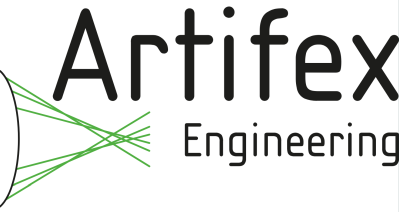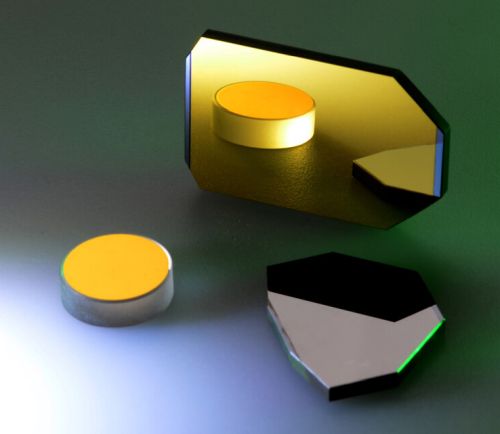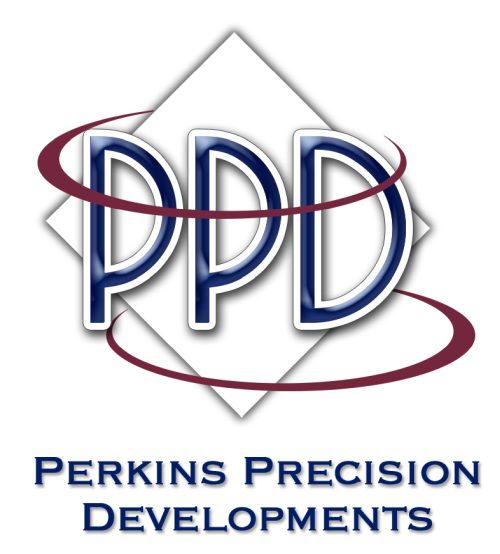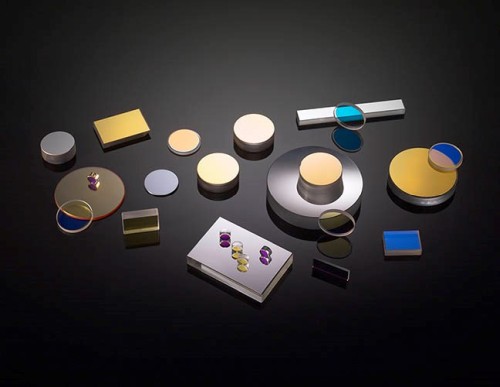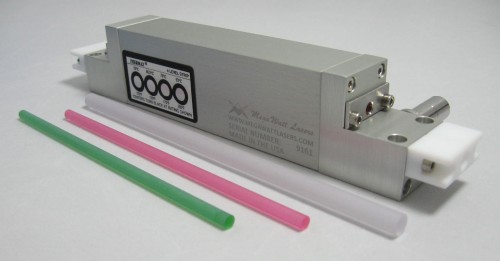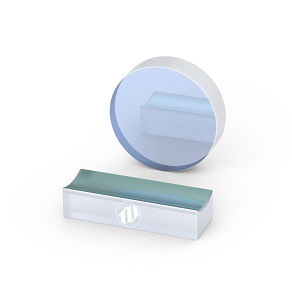mirrors (original) (raw)
Definition: devices which reflect light
-
- reflectors
* retroreflectors
* mirrors
* metal-coated mirrors
* dielectric mirrors
* dispersive mirrors
* Bragg mirrors
* crystalline mirrors
* first surface mirrors
* parabolic mirrors
* variable reflectivity mirrors
* deformable mirrors
* laser mirrors
* laser line mirrors
* fiber loop mirrors
* semiconductor saturable absorber mirrors
* supermirrors
* (more topics)
* fiber loop mirrors
- reflectors
-
- reflective optical elements
* mirrors
* metal-coated mirrors
* dielectric mirrors
* dispersive mirrors
* Bragg mirrors
* crystalline mirrors
* first surface mirrors
* parabolic mirrors
* variable reflectivity mirrors
* deformable mirrors
* laser mirrors
* laser line mirrors
* fiber loop mirrors
* semiconductor saturable absorber mirrors
* supermirrors
* (more topics)
* reflectors
* retroreflectors
* corner cube prisms
* axicons
- reflective optical elements
Related: reflectionreflectorsreflectivityreflectancemetal-coated mirrorsdielectric mirrorsBragg mirrorsquarter-wave mirrorscrystalline mirrorsdeformable mirrorslaser mirrorsoutput couplers
Page views in 12 months: 2206
DOI: 10.61835/zww Cite the article: BibTex BibLaTex plain textHTML Link to this page! LinkedIn
Content quality and neutrality are maintained according to our editorial policy.
📦 For purchasing mirrors, use the RP Photonics Buyer's Guide — an expert-curated directory for finding all relevant suppliers, which also offers advanced purchasing assistance.
Contents
What are Mirrors?
A mirror is an optical device which can reflect light. Usually, only those devices are meant where the reflection is of specular type and the angle of reflection equals the angle of incidence (see Figure 1). This means that reflective diffusers and diffraction gratings, for example, are not considered as mirrors, although they also reflect light in a way.
A somewhat more general term is reflector. While all mirrors are reflectors, there are reflectors which are somewhat more complex than a simple mirror. For example, there are prisms used as retroreflectors, using more than one total internal reflection at a prism surface.
Mirror surfaces are not necessarily flat; there are mirrors with a curved (convex or concave) reflecting surface (see below), which have focusing or defocusing properties.
This article deals mostly with optical mirrors as used in optics and laser technology, for example, and in other areas of photonics.
Properties of a Mirror
Various basic properties characterize a mirror:

Figure 1: Reflection of light on a mirror.
- The reflectivity (or reflectance) is the percentage of the optical power which is reflected. Generally, it depends on the wavelength and the angle of incidence, for non-normal incidence often also on the polarization direction.
- Mirrors often work only in a limited wavelength range, i.e., they exhibit the wanted reflectivity only within that range. The width of that range is called the reflection bandwidth. Of course, its exact value generally depends on the angle of incidence, the polarization and on the tolerance for the reflectivity.
- Similarly, there can be a limited range of angles of incidence, particularly for dielectric mirrors.
- The reflection phase is the phase shift of reflected light, i.e., the change in optical phase obtained when comparing light directly before and directly after the reflection. The phase shift can depend on the wavelength and the polarization direction. If the phase change is different between s and p polarization (for non-normal incidence), the polarization state of incident light will in general be modified, except if it is purely s or p polarization. That is exploited in phase-retarding mirrors, e.g. for converting linearly polarized light into circularly polarized light.
- The surface shape (e.g. spherically convex curved) is also relevant, see below.
Additional properties can be relevant in various applications:
- A high surface quality is often important in laser technology. The surface flatness of laser mirrors and others is often specified in wavelengths, e.g. λ / 10, at some given operating wavelength. As surface defects are largely a random phenomenon, worst-case or statistical specifications can be given. For small localized defects, it is common to give “scratch & dig” specifications according to the US standard MIL-REF-13830B: there are two numbers, quantifying the severity of scratches (shallow markings or tearings) and digs (pit-like holes) basically by a comparison of their visual appearance with those of defects in certain standard parts. A quality figure of simple parts could be 80-50, a commercial quality is 60-40, laser mirrors should normally have 20-10 or better, and high precision parts can have 10-5. There is also the standard ISO 10110-7, which also contains a more rigorous definition based on the size of defects rather than only their visual appearance.
- For use with high-power lasers, the optical damage threshold may be of interest — particularly in conjunction with pulsed lasers, as these tend to have high peak powers. It is often specified for nanosecond pulses.
- Chromatic dispersion properties are relevant in some applications, particularly those involving ultrashort pulses of light.
Types of Mirrors
Metal-coated Mirrors — Backside and First Surface Mirrors
Ordinary mirrors as used in households are often silver mirrors on glass. These basically consist of a glass plate with a silver coating on the backside. The silver coating is thick enough to suppress any significant transmission. Nevertheless, the reflectivity is substantially below 100%, since there are absorption losses of a few percent (for visible light) in the silver layer, apart from typically smaller losses in the glass. The essential advantage of such backside mirrors is that one has a robust glass surface outside, which can be cleaned easily, and the coating on the backside (with an additional layer) is well protected. For other applications, one uses first surface mirrors, where the light is incident directly on the coating and does not reach the mirror substrate. Here, one avoids the additional light transmission through glass.
For use in laser technology and general optics, more advanced types of first surface metal-coated mirrors have been developed. These often have additional dielectric layers on top of the metallic coating to improve the reflectivity and/or to protect the metallic coating against oxidation (enhanced and protected mirrors). Different metals can be used, e.g. gold, silver, aluminum, copper, beryllium and nickel/chrome alloys. Silver and aluminum mirrors are particularly popular. Others are mostly used as infrared mirrors.
The article on metal-coated mirrors gives more details.
Dielectric Mirrors
The most important type of mirror in laser technology and general optics is the dielectric mirror. This kind of mirror contains multiple thin dielectric layers. One exploits the combined effect of reflections at the interfaces between the different layers. A frequently used dielectric mirror design is that of a Bragg mirror (quarter-wave mirror), which is the simplest design and leads to the highest reflectivity at a particular wavelength (the Bragg wavelength). The reflectivity is high only within a limited wavelength band, which depends on the angle of incidence.

Figure 2: The reflectance spectrum of a Bragg mirror for different incidence angles from normal incidence (red) up to 60° (blue) in steps of 10°.
In contrast to some metal-coated mirrors, dielectric mirrors are usually made as first surface mirrors, which means that the reflecting surface is at the front surface, so that the light does not propagate through some transparent substrate before being reflected. That way, not only possible propagation losses in the transparent medium are avoided, but most importantly additional reflections at the front surface, which could be particularly relevant for non-normal incidence.
Generally, dielectric mirrors have a limited reflection bandwidth. (If that is outside the visible region, one may not even visually recognize the device as a mirror.) However, there are specially optimized broadband dielectric mirrors, where the reflection bandwidth can be hundreds of nanometers. Some of those are used in ultrafast laser and amplifier systems; they are sometimes called ultrafast mirrors, and they also need to be optimized in terms of chromatic dispersion.
Laser mirrors as used to form laser resonators, for example, are also usually dielectric mirrors, having a particularly high optical quality and often a high optical damage threshold. Some of them are used as laser line optics, i.e., only with certain laser lines. Also, there are supermirrors with a reflectivity extremely close to 100%, and dispersive mirrors with a systematically varied thin-film thickness. They can be used for high-Q optical resonators, for example.
In some cases, dielectric mirrors should also be polished on the backside — in particular, when some amount of light transmission is required, e.g. for output couplers of lasers.
Dielectric mirrors can be designed as cold mirrors or hot mirrors, which both can be used for removing unwanted infrared radiation — usually for reducing the thermal load on an optical system.
See the article on dielectric mirrors for more details.
Dichroic Mirrors
Dichroic mirrors are mirrors which have substantially different reflection properties for two different wavelengths. They are usually dielectric mirrors with a suitable thin-film design. For example, they can be used as harmonic separators in setups for nonlinear frequency conversion.

Figure 3: Reflectance spectrum of a dichroic mirror coating, designed with the software RP Coating for high transmittance (low reflectance) around 800–950 nm and high reflectance at 1064 nm.
Curved Mirrors
While many mirrors have a plane reflecting surface, many others are available with a curved (convex or concave) surface, for example for focusing laser beams or for imaging applications.
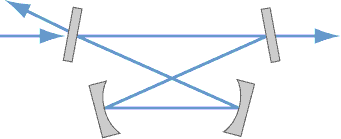
Figure 4: A ring resonator containing two curved mirrors. This feature is essential for defining resonator modes with an appropriate mode size and low power losses.
Most curved mirrors have a spherical surface, characterized by some radius of curvature ($R$). A mirror with a concave (inwards-curved) surface acts a focusing mirror, while a convex surface leads to defocusing behavior. Apart from the change in beam direction, such a mirror acts like a lens. For normal incidence, the focal length (disregarding its sign) is simply ($R / 2$), i.e., half the curvature radius. For non-normal incidence with an angle ($\theta$) against the normal direction, the focal length is ($(R / 2) \cdot \cos \theta$) in the tangential plane and ($(R / 2) / \cos \theta$) in the sagittal plane.
There are also parabolic mirrors, having a surface with a parabolic rather than spherical shape, which can be advantageous. For tight focusing, one often uses off-axis parabolic mirrors, which allow one to have the focus well outside the incoming beam.
Deformable Mirrors
There are deformable mirrors, where the surface shape can be controlled, often with many degrees of freedom (possibly several thousands). Such mirrors are mostly used in adaptive optics for correcting wavefront distortions.
Variable Reflectivity Mirrors
While most mirrors have a uniform reflectance across their reflecting area, there are also variable reflectivity mirrors, where the reflectance depends on the position. These are also called graded reflectivity mirrors. They are used in lasers with unstable resonators, also as variable optical attenuators.
Mirrors for Special Functions
Some types of mirrors are used for special functions:
Phase-retarding Mirrors
Phase-retarding mirrors are made such that they introduce a well-defined phase difference for s- and p-polarized components of a beam. For example, they can be used for converting linearly polarized light into circularly polarized light if that phase difference is ($\pi /2$).
Absorbing Thin-film Reflectors
Absorbing thin-film reflectors are metal-coated mirrors which are designed to reflect e.g. s-polarized light at 45° angle of incidence while absorbing p-polarized light with the same direction of incidence. They work e.g. at the common CO2 laser wavelength of 10.6 μm and can be used in conjunction with a phase-retarding mirror to build a kind of polarization-based optical isolator. Such a device can e.g. be used for preventing light reflected on a workpiece from getting back to the laser. However, it can be used only for moderate power levels because otherwise the absorbed power would destroy the mirror or at least degrade its performance.
Substrate Shapes
Mirror substrates in optics and laser technology often have a cylindrical form, for example with a diameter of 1 inch and a thickness of a couple of millimeters. However, there are also substrates with a rectangular, elliptical or D-shaped front surface, for example. Besides, there are prism mirrors, where a reflecting coating is placed on a prism, and retroreflectors.
For special applications, a mirror substrate with a tiny hole is used. This can be useful, for example, for combining two laser beams, one of which is sent in a focused fashion through the hole while the other beam, having a substantially larger diameter, is reflected on the mirror surface.
Mirrors in Fiber Optics
In fiber optics, it is also often required to reflect light — in most cases back into the fiber where the light came from. That can be achieved simply by butting a normal kind of mirror (e.g. a dielectric mirror) to a normally cleaved fiber end. Alternatively, one may apply a dielectric coating directly on a fiber end.
There are also completely different types of fiber reflectors, e.g. fiber loop mirrors which are strictly speaking no mirrors but another type of reflectors.
Suppliers
Sponsored content: The RP Photonics Buyer's Guide contains 204 suppliers for mirrors. Among them:
⚙ hardware
UltraFast Innovations (UFI®) provides a range of mirrors mostly for ultrafast lasers. We particularly emphasize mirrors with broad bandwidth and well controlled chromatic dispersion.
⚙ hardware
Artifex Engineering offers custom mirrors tailored to your requirements. Our mirrors can be manufactured in almost any shape: round, rectangular, elliptical, or any other shape including cut-outs and drill holes. Holes may also be drilled at an angle to the surface normal. We offer dielectric coatings and metal coatings (aluminium, silver or gold) with protective overcoat. Dielectric coatings are particularly developed for the respective application and enable precise wavelength ranges, so that individual wavelengths or selected ranges can be specified. Visit our product page for more information. We look forward to your inquiry.
⚙ hardware
Perkins Precision Developments (PPD) manufactures high energy laser mirrors and precision optics for both prototype and volume OEM requirements. We also offer custom Ion Beam Sputtered (IBS) thin film coatings for visible to near-infrared wavelengths on customer supplied substrates. PPD utilizes IBS coating technology because it is ideal for complex spectral designs, high power lasers and applications where it is critical to minimize losses from absorption and scatter.
Typical mirror coatings include dielectric low-loss high reflectors (HR), multi-wavelength high reflectors, dichroic mirrors, trichroic mirrors, partial beam splitter mirrors, non-polarizing and dispersion controlled mirrors.
⚙ hardware
IRD Glass manufactures first surface and second surface flat mirrors and laser mirrors that are used for interferometry, beam steering or folding, and many optical components within imaging systems. Our optical mirrors are completely customizable to meet our clients’ needs. From a basic protected aluminum through high laser damage threshold mirrors, IRD will certify the performance and specifications with whatever data you require.
⚙ hardware
We offer custom optical mirrors on glass, fused silica, plastic or metal substrates. Round, parabolic, conic and free-form shapes. High quality high reflective coatings: silver, aluminium, gold or dielectric multi-layer designs.
⚙ hardware
Ecoptik can provide the round, square and customized shape mirrors with a protected Al coating and UV Enhanced Al coating in various sizes.
⚙ hardware
EKSMA Optics has a wide selection of dielectric and metal-coated mirrors on stock. Precision custom mirrors can be manufactured upon request.
⚙ hardware
MegaWatt Lasers has a large inventory of HR and OC mirrors for 1064 nm, 2.1 μm and 2.94 μm wavelengths. We also can assist in specification of optics for these wavelengths.
⚙ hardware
At Shanghai Optics we manufacture custom optical precision mirrors for a wide range of applications. Life sciences, astronomy, metrology, and solar engineering are only a few of the industries which depend on our precision mirrors and other optical components.
⚙ hardware🧩 accessories and parts🧴 consumables🔧 maintenance, repair📏 metrology, calibration, testing💡 consulting🧰 development
Discover the pinnacle of technologies with Shalom EO’s optical mirrors, where our diverse catalogs of mirror types like broadband dieletric mirrors, laser line dieletric mirrors, laser output couplers, metallic mirrors, femtoline low-GDD mirrors, high power laser mirrors, chirped mirrors and pairs, ultrafast-enhanced silver mirrors, super polished mirrors and mirror blanks cater to all sorts of demands. In addition, we also provide CO2 laser mirrors.
Shalom EO utilizes the cutting-edge ion-assisted electron beam evaporation coating technologies to realize pre-defined coating designs, where this coating technique contributes to denser film deposition and hence a higher laser induced damage threshold. The IAD e-beam coating technique, in combination with our precision-processed mirror substrates (which can be made from Corning glass, Schott glass), guarantees the good quality of our mirrors.
⚙ hardware
LASEROPTIK can produce a wide range of laser mirrors with high reflectivity (HR) or partial reflectivity at given wavelength. We can also make specialty mirrors, e.g. with extremely broad reflection bands.
We use different coating technologies depending on your detailed requirements.
⚙ hardware
Avantier specializes in producing custom optical precision mirrors for various applications, including but not limited to life sciences, astronomy, metrology, and solar engineering. These industries rely on our precision mirrors and other optical components to meet their specific needs.
⚙ hardware
OPTOMAN manufactures a range of application-optimized laser mirrors, including extreme low-loss mirrors, dispersive mirrors, low GDD ultrafast mirrors and laser line mirrors. We focus on a single manufacturing technology — ion beam sputtering (IBS). OPTOMAN's IBS-coated mirrors feature high LIDT, spectral accuracy and environmental stability.
Standard in-stock IBS coated mirrors can be found in OPTOSHOP.
⚙ hardware
Edmund Optics offers a range of laser mirrors for use from the extreme ultraviolet (EUV) to the far IR. Laser mirrors designed for dye, diode, Nd:YAG, Nd:YLF, Yb:YAG, Ti:sapphire, fiber, and many more laser sources are available as flat mirrors, right angle mirrors, concave mirrors, and other specialty shapes. Ultrafast laser line mirrors designed to provide high reflection with minimal group delay dispersion (GDD) for femtosecond pulsed lasers including Er:glass, Ti:sapphire, and Yb:doped laser sources are also available.
⚙ hardware
Knight Optical offer stock mirrors including concave, elliptical, concave lamp reflectors and plane mirrors. Our mirror coatings include UV enhanced aluminium (180–650 nm), enhanced aluminium (450–650 nm), visible dielectric (450–700 nm), NIR dielectric (700–1064 nm), ion-plated silver (450–2000 nm), and protected gold (750 nm-far IR).
If your requirements are not met by our stock components, we can provide custom mirrors manufactured to your specifications.
Questions and Comments from Users
Here you can submit questions and comments. As far as they get accepted by the author, they will appear above this paragraph together with the author’s answer. The author will decide on acceptance based on certain criteria. Essentially, the issue must be of sufficiently broad interest.
Please do not enter personal data here. (See also our privacy declaration.) If you wish to receive personal feedback or consultancy from the author, please contact him, e.g. via e-mail.
By submitting the information, you give your consent to the potential publication of your inputs on our website according to our rules. (If you later retract your consent, we will delete those inputs.) As your inputs are first reviewed by the author, they may be published with some delay.
 general optics
general optics

